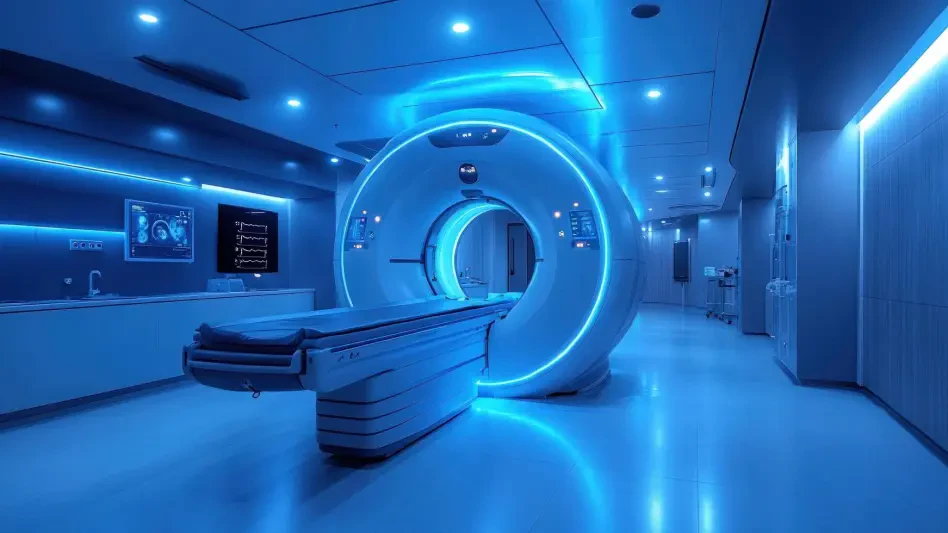Prostate cancer remains a leading health challenge for men worldwide, with millions diagnosed each year and many facing delayed or inaccurate results due to limitations in current diagnostic methods. This pervasive issue underscores a critical need for innovation in medical imaging, where missed or overdiagnosed cases can drastically alter patient outcomes. A groundbreaking development in artificial intelligence (AI) offers hope, as automated MRI systems emerge to transform the landscape of prostate cancer detection with unprecedented precision and efficiency. This report delves into how AI-powered technology is reshaping diagnostics, addressing longstanding challenges, and paving the way for a new era in personalized healthcare.
Revolutionizing Prostate Cancer Diagnostics with AI Technology
Prostate cancer stands as one of the most prevalent cancers among men globally, contributing to significant morbidity and mortality rates. The urgency for accurate and timely detection cannot be overstated, as early intervention often determines survival. Traditional diagnostic approaches, primarily relying on multiparametric MRI (mpMRI), have been instrumental but are hampered by subjective interpretation and variability among radiologists, often leading to inconsistent results.
Despite the effectiveness of mpMRI in identifying potential tumors, its dependence on human expertise introduces discrepancies that can result in missed diagnoses or unnecessary procedures. These limitations highlight a gap in the current system, where diagnostic accuracy can vary widely based on experience levels and individual judgment. Such challenges have spurred the demand for solutions that can standardize and enhance the diagnostic process.
Enter AI-powered MRI systems, a transformative leap forward in addressing these shortcomings. Leveraging advanced technologies like deep learning and convolutional neural networks (CNNs), these systems analyze vast datasets of imaging and biopsy results to deliver objective, consistent findings. Supported by researchers, healthcare providers, and tech innovators, this development promises to improve patient outcomes by reducing diagnostic errors and ensuring that critical cases are flagged with greater accuracy.
Innovations and Impact of AI in Prostate Cancer Detection
Key Technological Advancements and Trends
At the heart of AI-powered MRI systems lie cutting-edge innovations, particularly deep learning algorithms trained on extensive collections of MRI scans paired with confirmed biopsy outcomes. These algorithms excel at identifying subtle patterns indicative of clinically significant prostate cancer, distinguishing them from benign conditions. This capability tackles a major issue in diagnostics—overdiagnosis—by ensuring that only relevant cases prompt further intervention.
Beyond detection, emerging trends focus on integrating AI tools into clinical workflows with practical features like heatmaps and lesion segmentation. These visual aids empower radiologists to make informed decisions swiftly, enhancing treatment planning and patient communication. Such integration streamlines processes in high-pressure environments, reducing the cognitive load on medical professionals.
Moreover, AI opens doors to early detection and personalized treatment through precision medicine. By analyzing individual patient data, these systems can suggest tailored approaches, optimizing therapeutic outcomes. The continuous evolution of this technology signals a shift toward more proactive and customized healthcare strategies, setting a new standard for oncology diagnostics.
Clinical Performance and Market Potential
Validation studies reveal that AI-powered MRI systems achieve sensitivity and specificity rates that rival or surpass those of seasoned radiologists. This performance, tested across diverse patient cohorts and imaging protocols, underscores the reliability of these tools in real-world scenarios. Such results position AI as a formidable ally in enhancing diagnostic precision on a broad scale.
Implementation in clinical settings further demonstrates tangible benefits, including improved efficiency within radiology departments. Rapid processing times alleviate bottlenecks, cutting down diagnostic delays and allowing for quicker patient management. Hospitals adopting these systems report smoother operations, which translate to better care delivery and higher patient satisfaction.
Looking ahead, market adoption of AI diagnostic tools appears poised for significant growth, driven by rising demand for accurate and scalable solutions. From urban medical centers to rural clinics, the potential to deploy these systems across varied healthcare settings offers a promising outlook. As investment in health tech surges, the scalability of AI tools could redefine standards in prostate cancer care over the coming years, particularly from now through 2027.
Challenges in Implementing AI-Powered MRI Systems
The path to widespread adoption of AI-powered MRI systems is not without obstacles, particularly on the technical front. High-quality MRI data remains a prerequisite for effective algorithm training, yet inconsistencies in imaging standards across facilities pose a hurdle. Additionally, the underrepresentation of rare cancer subtypes in datasets limits the system’s ability to detect less common variants, necessitating broader data inclusion.
Regulatory challenges also loom large, as securing approvals from health authorities demands rigorous validation and adherence to stringent standards. Compliance with data privacy laws and clinical guidelines adds layers of complexity to deployment. These hurdles require meticulous planning and collaboration between tech developers and regulatory bodies to ensure safe integration into medical practice.
Market-driven issues, such as clinician resistance due to unfamiliarity or trust concerns, further complicate adoption. Addressing this involves targeted education programs to bridge knowledge gaps and phased integration strategies to build confidence in AI tools. Overcoming these barriers through external validation, inclusive data collection, and continuous model refinement via federated learning will be critical to unlocking the full potential of this technology.
Regulatory and Ethical Landscape for AI in Medical Imaging
Navigating the regulatory framework for AI diagnostic tools involves strict adherence to data privacy laws and clinical validation requirements. Agencies worldwide mandate thorough testing to confirm safety and efficacy, ensuring that patient data remains secure during system development and use. This oversight is vital for maintaining public trust in emerging medical technologies.
Ethical considerations play an equally important role, with transparency in algorithmic decision-making standing as a cornerstone. Patient confidentiality must be safeguarded, and AI must serve as an assistive tool rather than a substitute for human expertise. Striking this balance ensures that radiologists retain control over final diagnoses while benefiting from technological support.
Federated learning emerges as a key strategy in this context, enabling model improvement without compromising privacy by training algorithms on decentralized data. This approach aligns with global healthcare standards, fostering accountability and ethical deployment. Compliance with these principles shapes industry practices, reinforcing trust among clinicians and patients alike as AI becomes more embedded in medical imaging.
Future Outlook for AI-Enhanced Prostate Cancer Diagnostics
The potential of AI-powered MRI systems extends far beyond prostate cancer, with applications in other oncological fields such as breast and brain cancer imaging on the horizon. Adapting these tools to diverse cancer types could revolutionize diagnostics across specialties, offering a unified platform for comprehensive care. Such expansion signals a broader impact on oncology as a whole.
Emerging technologies, including the integration of multi-omics data like genomic and proteomic profiles with imaging, promise a more holistic diagnostic approach. This convergence could yield deeper insights into disease mechanisms, enabling highly personalized treatment plans. As research progresses, these multidimensional tools may become standard in clinical practice.
Market disruptors, such as cost-effective solutions tailored for low-resource settings, also hold transformative potential. Addressing global health disparities through accessible AI diagnostics could bridge gaps in care delivery, especially in underserved regions. Ongoing innovation, evolving regulatory landscapes, and shifting consumer expectations for personalized healthcare will continue to shape this dynamic field.
Transforming Prostate Cancer Care with AI
Reflecting on the journey of AI-powered MRI systems in prostate cancer detection, it becomes evident that this technology marks a turning point in diagnostic accuracy and workflow efficiency. The ability to minimize variability and distinguish critical cases reshapes clinical approaches, offering a lifeline to countless patients. Its integration into diverse healthcare settings demonstrates a scalability that was once thought unattainable.
The societal impact is profound, as enhanced access to quality diagnostics reaches underserved regions, narrowing global health gaps. Cost savings for healthcare systems emerge as a significant byproduct, with reduced unnecessary procedures alleviating financial burdens. These achievements underscore the value of sustained investment in health tech.
Moving forward, stakeholders are encouraged to prioritize scalable, ethical solutions by fostering collaborations between tech innovators and medical professionals. Supporting ongoing research to expand AI applications to other cancers is deemed essential, alongside efforts to refine data inclusivity and regulatory frameworks. These actionable steps promise to cement AI’s role as a cornerstone of future medical imaging, driving toward a more equitable and precise healthcare landscape.









